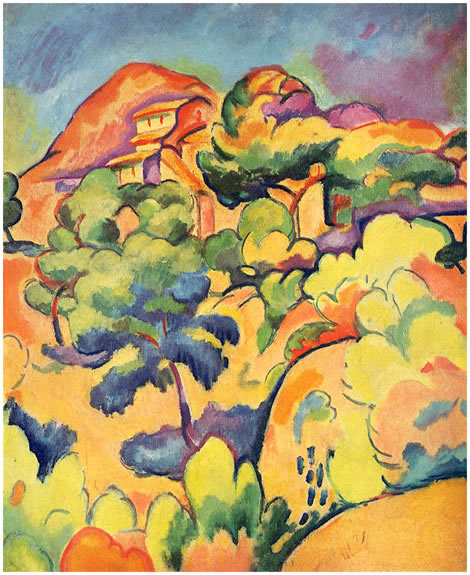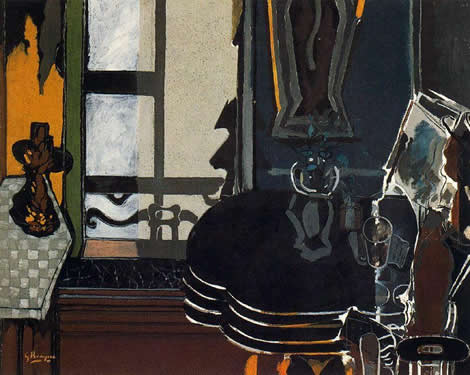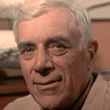Paintings

Landscape at La Ciotat
1907. Oil on Canvas 71.1 x 59.7 cm.
Museum of Modern Art, New York.
Encouraged by his success
at the Salon des Indepéndents in
1907, where he sold all six canvases exhibited, Braque came to the
French Riviera, settling for a while at La Ciotat, between Marseilles
and Toulon. Here in the hills behind the town, in a countryside
familiar to Cezánne, he painted this popular study, so redolent of the
older master but entirely different in outlook and technique. For
Cezánne, each stroke of the brush was an effort, and there were many
corrections and downright failures. Braque's piece simply accepts the
flat nature of the canvas, and lays out a pleasing composition with
fluid shapes. The upward movement of Cezánne's late work is retained,
but there is still some sense of depth created by overlapping planes.
Trees, hills and building are simplified, but the units are conceived
not as tiled brush strokes but as coherent theater flats filled with
vibrant color. And whereas Cezánne's work is invariably laboriously
composed, this piece is simple, joyous and decorative, exhibiting a
good eye for color harmony: the blue-violets of the sky are repeated in
the trees and other foliage. Color is now serving emotive and not
descriptive ends, and while academicians might deplore the exuberant
naivety, the way was now open to other ways of filling the canvas.

Still Life with Playing
Cards 1913. Oil on Canvas. 80 cm. x 59
cm. Musée d'Art Moderne, Paris.
Braque's return to Paris
in 1907 coincided with a Cezánne
retrospective at the Salon d'Automne, and Picasso's work on Les
Demoiselles d'Avignon in his Rue Ravignan studio. In December 1907,
Braque began his own monumental nude, worked on heavily throughout the
winter, but not so expressive and 'primitive' as Picasso's. He went
back to the l'Estaque in the summer, and now painted a series of
austere landscapes, muted in color and composed of rectangular slabs
and blocks (hills and houses) and cylinders (trees). All were rejected
by the Salon d'Automne of 1908. Like Cezánne before him, Braque then
turned to still lifes, painting pitchers, cups, fruit, cards,
newspapers, guitars, violins, etc. in an increasingly fragmented way.
Colors became muted, muddy even, though Braque usually breaks up the
planes into facets of brush strokes that add an an air of ambiguity:
quite where these elemental shapes exist in the third dimension is
never clear. Gradually this 'analytical' period of Cubism became
exhausted: the subjects had dissolved into abstract medleys of dull
gray and brown planes — 'interesting' work but not attractive nor
offering obvious avenues of development. In July 1912, Braque joined
forces with Picasso and hammered out a new style: 'synthetic' Cubism.
Just as he had dropped Cezánne's analysis of form in the La Ciotat
landscape, so Braque now divorced color from form, and made collages of
recognizable cutouts, the cutouts being painted, or simply strips of
wallpaper, oilcloth or newspaper glued in place.
So the work above, where
we see a round card table, the odd
drawing of a card, a bunch of grapes and bit of lettering, and various
panels, sometimes patterned or left a bluish gray. Perhaps the upright
shapes are players, or shapes borrowed from violins, etc. It hardly
matters: the work is largely abstract and to appreciate the piece we
have to like its balance of elements, their staccato rhythms, and
effectiveness of the decoration, simple but not boring. (Also worth
noting are the elongated panels that appear in de Staël's much later
painting of the Musicians,
and indeed the painters were close friends.)

The Salon 1944. Oil on
Canvas. 350 cm. × 279 cm. Musée d'Art
Moderne, Paris.
Synthetic Cubism is the
style
Braque stayed with till the end. The subjects were everyday objects of
a
middle class home, but Braque nvested them with a strange
intensity, as though we were seeing aspects of them in a new way. "The
Salon" was painted just after liberation from the German
occupation, and shows a world not somber but resplendent. Though three
quarters of the painting is dark, and large areas are left undecorated,
the reflection on the table and the wine glass etc. on the right
suggest a sparkle or deep celebration to the scene. The distortions of
Cubism — multiple viewpoints — are everywhere, and the familiar
outlines are simply painted or scratched through to the canvas, but
their improvised nature adds an air of mystery. What is that strange
orange panel in the top left? Or the smoky gray panel alongside: the
sky? What is that tangle of outlines beside the wine glass portraying?
There is no master plan: Braque has painted what he can, and then
stopped. Beyond lies abstract expressionism and new ideas of art
altogether, but Braque as a good bourgeois has stayed within the world
he knows. How that is accomplished, the precise balance of the
conventional with the experimental, is what forty years of painting
represent, and the achievement passes into what sympathetic critics
recognize but cannot fully explain. Painting, in short, is an art of
doing, of practical experience, and no amount of clever talk can
supersede the painterly sensibility that has to be slowly acquired.



